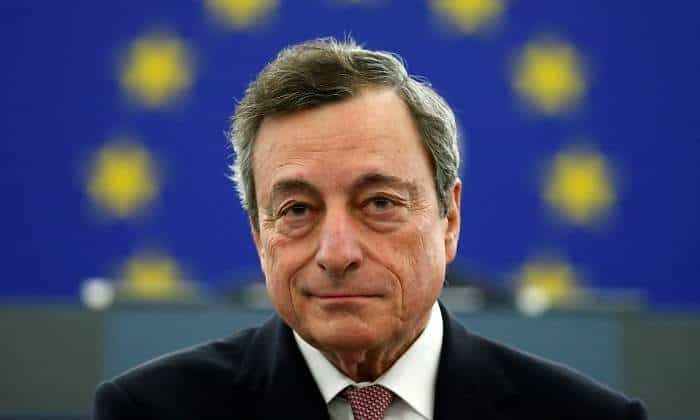Fra ABN Amro:
ECB View: QE open-ended but size too small to change the economic outlook – The ECB announcements were broadly in line with expectations in terms of rate cuts (a 10bp reduction in the deposit rate and signal of more to come) and mitigating measures for banks (more generous TLTRO conditions and a tiered deposit rate system).
The restart of net asset purchases was a mixed bag, as the size was relatively modest (EUR 20bn per month), but the programme is open-ended for the first time since the ECB launched the APP. The ECB said the programme would last as ‘long as necessary’. Despite the open-ended nature of the programme, the size of the QE programme is very small and, as such, the macroeconomic impact of these measures will be relatively modest.
As such we doubt whether this package of measures will be sufficient to raise inflation significantly over the next 2-3 years. Given this, and the modest pace of net asset purchases, QE will likely last for the foreseeable future, and a step up in the pace looks likely at some point.
Interest rate cuts and guidance – The ECB lowered the interest rate on the deposit facility by 10 bp to -0.50% as expected. The Governing Council also signalled the possibility that interest rates could be reduced further, saying that it expects the ‘key ECB interest rates to remain at their present or lower levels until we have seen the inflation outlook robustly converge to a level sufficiently close to, but below, 2% within our projection horizon, and such convergence has been consistently reflected in underlying inflation dynamics’.
Restart of QE – The Governing Council decided to restart net purchases under its asset purchase programme (APP) at a monthly pace of EUR 20bn as from 1 November. It expects them ‘to run for as long as necessary to reinforce the accommodative impact of our policy rates, and to end shortly before it starts to raise the key ECB interest rates’. The ECB did not change any of the modalities of the APP compared to the previous programme, except that the purchases of assets with yields below the deposit facility rate will be extended to covered bonds, corporate bonds and the ABS programme with immediate effect.
Furthermore, the relative composition of purchases will likely not change and the maximum maturity of bond purchases will be the same. Given the previous composition of the APP, we assume that monthly PSPP purchases will amount to around EUR 16.3bn per month, corporate bonds 2.4bn and covered bonds EUR 1.2bn. We calculate that the PSPP will not hit issue(r) limits for large markets for around a year given the current size and sovereign issuance trends. At that point, it would need to adjust these limits to continue the programme.
More generous TLTRO conditions – The ECB introduced two measures to mitigate some of the adverse effects on the banking system of negative rates. The modalities of the new series of quarterly targeted longer-term refinancing operations (TLTRO III) were made more generous. Under TLTRO III, banks can soon take loans from the ECB for 3-years at a rate as low as the deposit rate (-0.5%), if they meet specific loan lending criteria.
The new modalities are more favourable than the originally planned conditions which were 2 years at a premium of 10bp over the deposit rate. At the lower rate and longer maturity, it makes it more favourable for most eurozone banks to take up TLTRO funds compared to senior unsecured debt. That was not the case under the previous conditions.
Launch of tiered deposit rate – In another measure to mitigate the cost of negative interest rates for banks, the ECB launched a two-tier system for reserve remuneration in which part of banks’ holdings of excess liquidity will be exempt from the negative deposit facility rate. The ECB has chosen a ‘Swiss-style’ system where the proportion of exempted reserves is a factor of the amount of required reserves. The factor it has chosen is 6. This is not very generous as it will reduce costs to the eurozone banking sector as a whole by only around EUR 2bn per annum.
It seems that it did not go for a higher number as this would allow banks with low levels of excess liquidity (primarily in Italy and Spain) to increase their excess reserves to profit from the 0% charge under this system. In other words, the incentive to sell negative yielding assets to increase excess reserves and to have it charged at 0% has been mitigated. The ECB can increase the level of the factor going forward as excess reserves gradually rise due to resumption of net asset purchases.
ECB lowers growth and inflation projections yet again – The ECB also published its new Staff macroeconomic projections for the euro area today. It lowered its forecast for GDP growth in 2019 to 1.1% (it was 1.2%) and in 2020 to 1.2% (versus 1.4%), while keeping its forecast for 2021 unchanged at 1.4%. Moreover, the ECB added that the risks to growth continued to be tilted to the downside. The forecasts for inflation were reduced to 1.2% in 2019 (down from 1.3%), 1.0% in 2020 (versus 1.4%) and 1.5% in 2020 (versus 1.6%).
The forecasts for core inflation were reduced in a similar manner, to 1.0% in 2019, 1.2% in 2020 and 1.5% in 2021. During his press conference, ECB president Mario Draghi emphasized that these inflation projections were ‘well below the level that we consider to be in line with our aim’. Subsequently, he urged the countries that do have room for fiscal stimulus under the rules of the European fiscal past to act in an ‘effective and timely manner” to support their economies.
He added that according to the Governing Council, fiscal policy should become the main instrument for supporting the economy and that there was complete agreement about that. Compared to our own forecasts for GDP growth (0.8% in 2019 and 0.6% in 2020) and core inflation (1.0% in 2019 and 0.9% in 2020), the ECB’s projections still are relatively high.
Package is not enough – We think that the policy stimulus measures that were announced by the ECB today will not be sufficient to lift inflation back into the direction of the ECB’s target. The ECB presented estimates of the impact of its unconventional polies between 2014 and 2018 on the economic outlook and we find those instructive in judging the impact of its current package.
Chief Economist Philip Lane presented estimates suggesting that by 2018 the complete package left economic growth around a percentage point higher and inflation around 0.5 percentage points higher compared to the counterfactual. The ECB is currently trying to close an inflation gap of 0.4 percentage points yet policy rate cuts and the level of net asset purchases are more modest, while the TLTRO is less generous compared to back then.
For instance, in the first year, purchases under the APP totalled EUR 60bn per month, while they totalled EUR 80bn per month in the second year. Overall, we think that the macroeconomic effects of this package will be modest. This policy response is pretty far removed from a ‘whatever it takes’ to get inflation up.
ECB Outlook – Given the modest initial package and that we are more pessimistic than the ECB on the economic outlook, we think that the central bank will need to do more going forward . This assumes that we will not see the significant fiscal stimulus that Mr Draghi has been pleading for. The pace of net asset purchases could well be stepped up, while in any case, we would expect net purchases to continue for the foreseeable future. Meanwhile, we expect an additional 10bp reduction of the deposit rate








